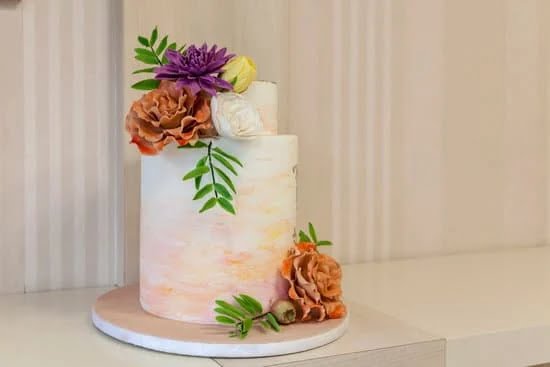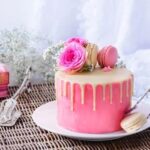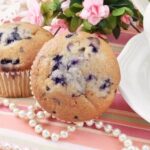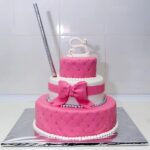If the idea of cake decorating has always intimidated you, fear no more. Contrary to common misconceptions, cake decorating is actually easier than you might think.
In this blog post, we will debunk those myths and show you just how accessible and enjoyable cake decorating can be for beginners. Whether you’re a complete novice or have a little experience under your belt, this article is suitable for anyone looking to enhance their baking skills and create stunning cakes that are sure to impress.
In this introductory section, we’ll address some of the commonly held beliefs about cake decorating that often discourage beginners from trying their hand at it.
We’ll provide an overview of what to expect throughout the rest of the article, covering essential tools and supplies needed for cake decorating, understanding different types of frosting and icing, step-by-step guides for baking perfect cakes, basic techniques for beginners, decoration ideas for different occasions, troubleshooting common issues, and even tips on taking your cake decorating skills to the next level.
By the end of this article, you’ll realize that with dedication and practice, anyone can become skilled at cake decorating. So let go of any doubts or apprehensions you may have had in the past. It’s time to unleash your creativity in the kitchen and start creating your own amazing cakes.
Essential Tools and Supplies for Cake Decorating
Cake decorating may seem like a daunting task, but with the right tools and supplies, it can be much easier than you think. In this section, we will discuss the essential tools needed for cake decorating, where to find affordable options, and how to effectively use them.
When it comes to cake decorating, a few basic tools are essential for beginners. Here are some must-haves:
- Piping Bags and Tips: Piping bags are used to pipe frosting onto the cake in various designs and patterns. They come in different sizes and materials such as disposable plastic or reusable cloth. Paired with piping tips of different shapes and sizes, you can create beautiful borders, flowers, and other decorative elements on your cakes.
- Offset Spatula: An offset spatula is an angled spatula with a flexible metal blade. This tool is perfect for spreading frosting evenly on your cakes and creating smooth surfaces.
- Turntable: A turntable is a rotating platform that allows you to easily maneuver and decorate your cake from all angles. This helps achieve even frosting distribution and precise decorations.
- Cake Leveler: A cake leveler is used to trim the top of your cakes to ensure they have an even surface for stacking or decorating layer cakes.
- Decorating Comb/Scraper: This tool creates texture on the sides of your frosted cake by combing through the frosting. It adds professional-looking designs without much effort.
- Fondant Tools: If you plan on working with fondant, you’ll need specific tools like fondant rollers, cutters, impression mats, and shaping tools for sculpting intricate designs.
Now that you know what tools you need for cake decorating let’s talk about where to buy them affordably:
- Local Kitchenware Stores: Check out local kitchenware stores or baking supply shops near you for a variety of options.
- Online Retailers: Websites like Amazon, Wilton, and Michaels offer a wide range of cake decorating tools at various price points. Read reviews from other customers to make informed purchasing decisions.
Remember, practice is key when it comes to mastering cake decorating techniques. Don’t get discouraged if your first attempts don’t turn out perfect. With dedication and the right tools, you’ll be able to create beautiful cakes in no time.
| Essential Cake Decorating Tools | Where to Buy |
|---|---|
| Piping Bags and Tips | Local kitchenware stores, online retailers (Amazon, Wilton, Michaels) |
| Offset Spatula | Local kitchenware stores, online retailers (Amazon, Wilton, Michaels) |
| Turntable | Local kitchenware stores, online retailers (Amazon, Wilton, Michaels) |
| Cake Leveler | Local kitchenware stores, online retailers (Amazon, Wilton, Michaels) |
| Decorating Comb/Scraper | Local kitchenware stores, online retailers (Amazon, Wilton, Michaels) |
Understanding Different Types of Frosting and Icing
Frosting and icing are essential elements in cake decorating, and understanding the different types is key to creating beautiful and delicious cakes. In this section, we will explore the differences between buttercream, royal icing, fondant, and ganache, discussing their pros and cons for various cake designs and techniques.
1. Buttercream:
Buttercream is a classic frosting made from butter, powdered sugar, and flavorings such as vanilla or chocolate. It is creamy, smooth, and versatile, making it a popular choice for both filling and frosting cakes. The great thing about buttercream is that it can be easily flavored and colored to match any theme or occasion. It is relatively easy to work with and provides a soft texture that pairs well with most cake flavors.
2. Royal Icing:
Royal icing is a hard-drying icing made from confectioners’ sugar and egg whites or meringue powder. It sets into a firm finish which makes it ideal for intricate piping work like creating delicate flowers or intricate lace patterns on cakes. Royal icing can also be used to assemble gingerbread houses or decorate cookies.
3. Fondant:
Fondant is a pliable dough-like substance that can be rolled out and draped over cakes for a smooth finish. It gives cakes a polished and professional look but tends to have a more firm texture than buttercream when eaten. Fondant comes in ready-to-use sheets or can be made from scratch using marshmallows or gelatin.
4Ganache:
Ganache is a rich mixture of chocolate and cream that creates a glossy glaze when poured over the cake or whipped into frosting consistency when cooled. It has an intense chocolate flavor that pairs well with many cake flavors like chocolate or red velvet. Ganache can also be used as filling between layers of cake for an extra decadent touch.
Each type of frosting/icing has its advantages depending on the desired look, taste, and ease of use. Experimenting with different types will help you find your preferred style of cake decorating. In the next section, we will provide simple recipes for homemade frostings and icings that you can try out for your next cake decorating project.
Step-by-Step Guide to Baking a Perfect Cake
Baking a perfect cake is an essential skill for any aspiring cake decorator. Whether you are a beginner or have some baking experience, following a step-by-step guide can help ensure that your cakes turn out delicious and aesthetically pleasing. In this section, we will provide foolproof recipes for various types of cake bases, offer tips and tricks for achieving even layers and proper cake structure, and highlight common mistakes to avoid during the baking process.
Foolproof Cake Recipes
- Classic Vanilla Cake: A versatile recipe that serves as a great base for any type of decoration.
- Chocolate Cake: Rich and decadent, perfect for chocolate lovers.
- Lemon Cake: Light and refreshing, ideal for spring or summer-themed designs.
- Red Velvet Cake: A vibrant and velvety option that adds a pop of color to any occasion.
Tips for Even Layers
- Use cake strips or wet towels wrapped around the cake pans to ensure even baking.
- Measure the batter evenly into each pan using an ice cream scoop or kitchen scale.
- Bake at the recommended temperature and always perform the toothpick test before removing from the oven.
Proper Cake Structure
- Torting and Filling: Slice cakes horizontally into multiple layers using a sharp serrated knife. Apply fillings such as buttercream or fruit preserves between each layer.
- Crumb Coat: Apply a thin layer of frosting all over the assembled cake to seal in crumbs before applying the final coat of frosting.
- Cake Boards and Support: Use sturdy cake boards between layers when stacking tiered cakes. Insert dowels or straws into lower tiers to provide support for upper tiers.
Common Mistakes to Avoid
- Overmixing the batter, resulting in a dense and tough cake.
- Opening the oven door too often during baking, leading to uneven heat distribution and potential collapse.
- Improperly measuring ingredients, which can throw off the balance of flavors and textures.
By following these step-by-step guidelines, you will be well on your way to baking a perfect cake every time. Remember to practice patience and have fun experimenting with different recipes and flavors. In the next section, we will delve into basic cake decorating techniques for beginners, so stay tuned.
Basic Cake Decorating Techniques for Beginners
Decorating a cake can seem like a daunting task, especially for beginners. However, with the right techniques and some practice, anyone can create beautifully decorated cakes. In this section, we will cover some basic cake decorating techniques that are perfect for beginners looking to enhance their baking skills.
Piping
One of the most popular cake decorating techniques is piping. Piping involves using a pastry bag fitted with different tips to create decorative designs on a cake.
To begin, you will need to fill the pastry bag with the desired frosting or icing and twist the top of the bag to secure it. Hold the bag at a 45-degree angle above the cake and gently squeeze to release the frosting while moving your hand in a controlled manner to create the desired design.
Smoothing
Achieving smooth surfaces on your cake is essential for an elegant finish. Start by applying a thin layer of frosting or icing all over the cake using an offset spatula. Next, use a bench scraper or straight-edge tool against the sides of the cake with gentle pressure to smooth out any imperfections and create sharp edges.
Creating Borders
Adding borders can give your cake a polished look. There are many border designs you can choose from, such as shell borders, rope borders, or dot borders. To create a simple shell border, fit your pastry bag with a small round tip and hold it at about a 45-degree angle against the base of your cake. Squeeze gently while making small half-circle motions to form connected shells along the edge of your cake.
Remember that practice makes perfect when it comes to these basic techniques. Don’t be discouraged if your first attempts don’t turn out exactly as planned – keep practicing and experimenting with different designs and colors.
By mastering these fundamental techniques, you’ll be well on your way to creating beautifully decorated cakes that will impress family and friends. Don’t forget to refer back to the previous sections of this article for additional tips and inspiration as you embark on your cake decorating journey. Happy decorating.
Decorating Ideas for Different Occasions
When it comes to cake decorating, one of the most exciting aspects is creating unique designs and themes that are tailored to different occasions. Whether it’s a birthday, wedding, or holiday celebration, there are endless possibilities for transforming a plain cake into a showstopper. In this section, we will explore some easy and impressive cake designs for various occasions, provide tips on theme-based decorations and personalization, and showcase inspiring ideas through images and examples.
For birthdays, there are numerous ways to take the celebration to the next level with creative cake designs. Consider incorporating the recipient’s favorite colors, characters, or hobbies into the design. For a kids’ birthday party, you can make a cake shaped like their favorite animal or cartoon character.
Alternatively, you can create a whimsical themed cake using bright colors and fun patterns. Adding personalized messages or names using piped frosting or fondant cutouts can also add an extra touch of thoughtfulness.
Wedding cakes are often the centerpiece of a reception and should reflect the couple’s style and personality. Elegant designs such as tiered cakes adorned with delicate sugar flowers or lace piping are popular choices for traditional weddings. For those looking for a more modern twist, metallic accents like gold or silver leaf detailing can add a sophisticated touch. Couples who want something truly unique can consider non-traditional shapes like hexagons or asymmetrical tiers.
When it comes to holidays like Christmas or Halloween, adding festive elements to your cake can create a memorable centerpiece for any gathering. Decorate your Christmas cake with edible snowflakes made from royal icing or create a winter wonderland scene using sparkly white frosting and miniature figurines. For Halloween cakes, get creative with spooky designs such as carved pumpkin-shaped cakes, spiderweb patterns made from black buttercream frosting, or graveyard scenes complete with edible tombstones.
Remember that these ideas are just starting points; you have the creative freedom to modify and adapt them to suit your vision and personal style. Cake decorating is a chance to let your imagination run wild, so don’t be afraid to experiment with different techniques and designs. By using the right tools, frostings, and decorations, you can bring your cake decorating ideas to life and create stunning masterpieces that will impress everyone at any occasion.
Troubleshooting Common Cake Decorating Issues
Decorating a cake can be a fun and rewarding experience, but sometimes things don’t go as planned. This section will address some common cake decorating issues that beginners may encounter and provide helpful tips to overcome them.
One common issue is cracked fondant. Fondant is a popular choice for creating smooth and flawless cake designs, but it can be prone to cracking if not handled properly. To prevent this, make sure your fondant is rolled out evenly and not too thick. If you notice cracks while applying the fondant to the cake, gently smooth them out with your hands or use a smoothening tool. In case of large cracks, try patching them with additional pieces of fondant.
Another issue that beginners may face is melted buttercream. Buttercream is a versatile frosting that can be used for piping intricate designs or creating smooth finishes on cakes. However, it can melt easily in warm temperatures or when exposed to heat sources. To avoid this problem, ensure that your cake has cooled completely before frosting it with buttercream. If you’re working in a warm environment, consider refrigerating the cake periodically during the decorating process to keep the buttercream firm.
Uneven frosting is another challenge that decorators often encounter. To achieve an even layer of frosting on your cake, start by applying a crumb coat – a thin layer of frosting that acts as a base and helps seal in any loose crumbs.
Allow the crumb coat to set before adding additional layers of frosting. Use an offset spatula or bench scraper to spread the frosting evenly across the cake’s surface, turning the turntable as you go for a smoother finish.
| Cake Decorating Issue | Troubleshooting Tips |
|---|---|
| Cracked Fondant | Roll fondant evenly and not too thick. Smooth out cracks with hands or smoothening tool. |
| Melted Buttercream | Ensure cake is completely cooled before frosting. Consider refrigerating cake periodically during decorating. |
| Uneven Frosting | Apply a crumb coat first. Use an offset spatula or bench scraper to spread frosting evenly. |
By being aware of these common issues and following these troubleshooting tips, you can overcome obstacles in your cake decorating journey and create stunning masterpieces. Remember, practice makes perfect, so don’t be discouraged if things don’t turn out perfectly right away. With time and patience, you’ll become a confident cake decorator.
Taking Cake Decorating to the Next Level
Advanced Techniques to Master
Once you have mastered the basic cake decorating techniques and feel comfortable with your skills, it’s time to take your cake decorating to the next level. This section will introduce a few advanced techniques that will help you create even more stunning and professional-looking cakes.
One technique that can elevate your cake designs is using fondant to create intricate decorations and designs. Fondant allows for precise detailing and gives cakes a smooth, polished finish. To start working with fondant, make sure you have a clean, well-floured surface and rolling pin.
Roll out the fondant evenly and smoothly, then carefully drape it over your cake. Smooth any wrinkles or air bubbles using a fondant smoother or your hands. From there, you can get creative by sculpting shapes, using molds, or hand-painting on the fondant.
Another advanced technique to explore is creating intricate piping designs. Piping allows you to add delicate details and beautiful designs to your cakes. You’ll need a set of piping tips in various shapes and sizes, along with pastry bags and couplers.
Start by practicing basic piping techniques like dots, lines, rosettes, and ruffles. As you gain confidence, move on to more complex techniques such as lacework or basketweave patterns. Remember that consistency in pressure is crucial for achieving clean lines and shapes.
Exploring New Flavors and Fillings
As you advance in your cake decorating journey, don’t forget about experimenting with new flavors and fillings for your cakes. While classic flavors like vanilla and chocolate are always crowd-pleasers, trying out unique combinations can add an element of surprise to your creations.
Consider incorporating ingredients such as fruits, nuts, spices, or extracts into both the cake batter and the filling layers. For example, try adding fresh strawberries or lemon zest into a vanilla cake base for a refreshing twist. Experiment with different types of buttercream flavors, such as mocha, salted caramel, or raspberry. Don’t be afraid to mix and match flavors to create a truly unique and memorable cake.
Pushing Your Design Boundaries
Once you have a solid foundation in cake decorating, it’s time to let your imagination run wild and push the boundaries of your designs. This is where you can truly showcase your creativity and personal style.
Consider incorporating unconventional elements into your cake designs, such as edible flowers, metallic accents, or hand-painted details. Experiment with different textures like ruffles, lace patterns, or ombré effects. Explore more complex shapes and structures by using cake molds or carving techniques. The key is to challenge yourself and step outside of your comfort zone.
Remember, taking cake decorating to the next level is all about experimentation and embracing new challenges. Don’t be afraid to make mistakes along the way; they are inevitable and part of the learning process. The more you practice and explore advanced techniques, the more you will refine your skills and develop your own signature style in cake decorating. So go ahead, unleash your creativity, and create stunning cakes that will amaze everyone around you.
Conclusion
After reading this comprehensive guide to cake decorating, it’s clear that anyone can become skilled at creating their own amazing cakes. Throughout this blog post, we have addressed common misconceptions about cake decorating and provided a step-by-step breakdown of the essential tools, frosting options, baking techniques, and decoration ideas needed to create stunning cakes for any occasion.
One of the key takeaways from this guide is that cake decorating is easier than you think. By following the simple tips and techniques outlined in this article, even beginners can achieve professional-looking results. We have highlighted affordable options for tools and supplies, shared easy-to-follow recipes for homemade frostings and icings, and provided troubleshooting solutions for common issues.
It’s important to remember that practice makes perfect when it comes to cake decorating. Don’t be discouraged if your first attempts don’t turn out exactly as planned – every great cake decorator started as a beginner. The most important thing is to start experimenting and honing your skills. With dedication, patience, and creativity, you’ll soon be able to decorate your own amazing cakes that will impress friends and family.
In conclusion, with the knowledge gained from this article, you are ready to dive into the world of cake decorating. Whether you’re looking to create birthday masterpieces or elegant wedding cakes, the possibilities are endless. Remember to have fun throughout the process and embrace your own unique style. So grab your tools, get baking, and let your creativity shine through in every delicious creation.
Frequently Asked Questions
What does a beginner need for cake decorating?
For a beginner in cake decorating, there are a few essential tools and materials that are needed to get started. First and foremost, a set of basic decorating tips is necessary, as these will be used to create different designs and patterns on the cake. Along with this, a piping bag is essential for holding the icing as it is piped onto the cake.
A turntable is also useful, as it allows for easy rotation of the cake while decorating. Other tools such as spatulas, offset spatulas, and an icing smoother are important for spreading and smoothing the icing on the cake. Lastly, an assortment of food coloring gels or powders can be used to add color to the icing.
What is the easiest way to decorate a cake?
The easiest way to decorate a cake is often by using pre-made decorations such as sprinkles, edible pearls, or pre-made fondant shapes. These decorations can be simply placed onto the frosted cake without the need for any additional techniques or tools.
Another easy way to decorate a cake is by using stencils or templates to create simple designs with powdered sugar or cocoa powder dusted over them. This method requires minimal skills and can result in visually appealing designs.
What are the 3 tips for preparing to decorate a cake?
There are three important tips for preparing to decorate a cake: planning ahead, ensuring proper cooling of the cake layers, and having all necessary tools and ingredients ready. Planning ahead involves deciding on the theme or design of the cake and gathering any specific decorations or supplies needed for that design. It can also include sketching out ideas or making templates if required. Properly allowing the cake layers to cool before frosting them is crucial, as warm cakes can cause the icing to melt or become unstable during decoration.
It is recommended to let them cool completely on wire racks before proceeding with decoration. Lastly, having all tools and ingredients prepared in advance saves time during the decorating process. This includes measuring out ingredients accurately and setting up equipment like piping bags and tips, turntables, and spatulas so that they are readily available when needed.

Welcome to our cake decorating blog! My name is Destiny Flores, and I am the proud owner of a cake decorating business named Cake Karma. Our mission is to provide delicious, beautiful cakes for all occasions. We specialize in creating custom cakes that are tailored specifically to each customer’s individual needs and tastes.





